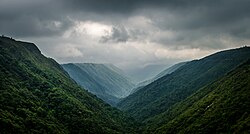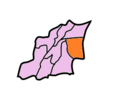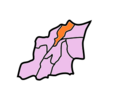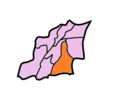East Khasi Hills district
Thank you for being part of the Bharatpedia family! 0% transparency: ₹0 raised out of ₹100,000 (0 supporter) |
East Khasi Hills district | |
|---|---|
 | |
| Country | India |
| State | Meghalaya |
| Headquarters | Shillong |
| Government | |
| • Vidhan Sabha constituencies | 7 |
| Area | |
| • Total | 2,752 km2 (1,063 sq mi) |
| Population (2011[1]) | |
| • Total | 825,922 |
| • Density | 300/km2 (780/sq mi) |
| Demographics | |
| • Literacy | 85.7% |
| • Sex ratio | 1008 |
| Time zone | UTC+05:30 (IST) |
| Major highways | NH-44, NH-40 |
| Website | eastkhasihills |
East Khasi Hills is an administrative district in the state of Meghalaya in India. The district headquarters are located at Shillong. The district occupies an area of 2752 km² and has a population of 825,922 (as of 2011). As of 2011 it is the most populous district of Meghalaya's 12 districts.[2]
History[edit]
The former Khasi Hills district was divided into East and West Khasi Hills districts on 28 October 1976. On 4 June 1992, East Khasi Hills District was further divided into two administrative districts of East Khasi Hills District and Ri-Bhoi District.
Geography[edit]
Shillong is the district headquarters of East Khasi Hills District.
East Khasi Hills District forms a central part of Meghalaya and covers a total geographical area of 2,748 km2. It lies approximately between 25°07" & 25°41" N Lat. And 91°21" & 92°09" E Long.
The north of the district is bounded by the plain of Ri-Bhoi District gradually rising to the rolling grasslands of the Shillong Plateau interspersed with river valleys, then falls sharply in the Southern portion forming a deep gorges and ravines in Mawsynram and Shella-Bholaganj, community and rural development block, bordering Bangladesh. The district is bounded by the Jaintia Hills District to the east and the West Khasi Hills District to the west.
The East Khasi Hills District is mostly hilly with deep gorges and ravines on the southern portion. The most important physiographic features of the district is the Shillong Plateau interspersed with river valley, then fall sharply in the southern portion forming deep gorges and ravine in Mawsynram and Shella-Bholaganj bordering Bangladesh. Shillong peak, 10 km from the city, offers a panoramic view of the scenic country side and is also the highest point in the district as well as in the State.
Climate[edit]
The climate of the district ranges from temperate in the plateau region to the warmer tropical and sub-tropical pockets on the Northern and Southern regions. The whole of the district is influenced by the south-west monsoon which begins generally from May and continues till September. The weather is humid for the major portion of the year except for the relatively dry spell usually between December and March.
| Climate data for Shillong | |||||||||||||
|---|---|---|---|---|---|---|---|---|---|---|---|---|---|
| Month | Jan | Feb | Mar | Apr | May | Jun | Jul | Aug | Sep | Oct | Nov | Dec | Year |
| Average high °F (°C) | 51 (11) |
54 (12) |
72 (22) |
75 (24) |
75 (24) |
75 (24) |
75 (24) |
77 (25) |
75 (24) |
63 (17) |
48 (9) |
43 (6) |
65 (19) |
| Average low °F (°C) | 33 (1) |
36 (2) |
54 (12) |
59 (15) |
61 (16) |
64 (18) |
66 (19) |
64 (18) |
64 (18) |
49 (9) |
32 (0) |
26 (−3) |
51 (10) |
| Average rainfall inches (mm) | 0.0 (1) |
0.1 (3) |
4.3 (109) |
12.3 (312) |
23.9 (607) |
43.7 (1,111) |
45.6 (1,159) |
29.2 (741) |
21.7 (552) |
9.5 (242) |
1.0 (25) |
0.6 (15) |
191.9 (4,877) |
| Average rainy days | 1 | 2 | 5 | 11 | 15 | 18 | 19 | 16 | 13 | 6 | 2 | 1 | 109 |
| Source: http://worldclimateguide.co.uk/climateguides/india/shillong.php | |||||||||||||
Divisions[edit]
Administrative divisions[edit]
East Khasi Hills division is divided into eight blocks:[3]
| Name | Headquarters | Population | Location |
| Khatarshnong Laitkroh | Mawjrong | ||
| Mawkynrew | Mawkynrew | ||
| Mawphlang | Mawphlang | ||
| Mawryngkneng | Mawryngkneng | ||
| Mawsynram | Mawsynram | ||
| Mylliem | Mylliem | ||
| Pynsursla | Pynsursla | ||
| Shella Bholaganj | Cherrapunjee |
Demographics[edit]
According to the 2011 census, East Khasi Hills district has a population of 825,922,[2] roughly equal to the nation of Comoros[4] or the US state of South Dakota.[5] This gives it a ranking of 478th in India (out of a total of 640).[2] The district has a population density of 292 inhabitants per square kilometre (760/sq mi) .[2] Its population growth rate over the decade 2001-2011 was 24.68%.[2] East Khasi Hills has a sex ratio of 1008 females for every 1000 males,[2] and a literacy rate of 84.7%.[2]
Culture[edit]
Places of interest[edit]
- Kongthong village is a popular tourist destination where people use the whistled language[6][7] and build living root bridges.
- Mawlynnong village, located in the Pynsursla block, is known for its cleanliness. The travel magazine Discover India declared the village as the cleanest in Asia in 2003, and the cleanest in India in 2005.[8]
- Nohkalikai Falls one of the tallest falls in India is located near Sohra (Cherrapunjee).
- Nohsngithiang Falls
- Shillong the headquarters of this district is a hill station with a number of tourist attraction all around.[citation needed]
- Sohra (Cherrapunjee) once the wettest place on the planet,[citation needed] also known for its living root bridges and is a tourist attraction.
- Sweet Falls located in Mawshabuit
- Umiam Lake an artificial lake on the way to Shillong.
Transport[edit]
The headquarters of the district, Shillong which is also the capital city of State, is connected to Guwahati and Silchar by NH 44 of 103 km and 240 km respectively. The nearest Rail head and airport are situated at Guwahati. There is an airstrip suitable for small aircraft at Umroi which is 35 km from Shillong. The agricultural and other products are transported by trucks, jeeps and tractors. Shillong is well connected with other parts of the State by motorable road. Similarly, all the block headquarters in the district are also connected by roads. However, the villages in the interior areas are poorly connected and transport services are inadequate.[citation needed]
Gallery[edit]
References[edit]
- ↑ "Archived copy". Archived from the original on 8 January 2013. Retrieved 29 September 2012.
{{cite web}}: CS1 maint: archived copy as title (link) - ↑ 2.0 2.1 2.2 2.3 2.4 2.5 2.6 "District Census 2011". Census2011.co.in. 2011. Retrieved 30 September 2011.
- ↑ Meghalaya Administrative Divisions (PDF) (Map). The Registrar General & Census Commissioner, India, New Delhi, Ministry of Home Affairs, Government of India. 2011. Retrieved 29 September 2011.
- ↑ US Directorate of Intelligence. "Country Comparison:Population". Archived from the original on 27 September 2011. Retrieved 1 October 2011.
Comoros 794,683 July 2011 est.
- ↑ "2010 Resident Population Data". U. S. Census Bureau. Archived from the original on 19 October 2013. Retrieved 30 September 2011.
South Dakota 814,180
- ↑ "Kongthong – A Village in Meghalaya where People Whistle to Communicate". amazingindiablog.in. 10 August 2017. Retrieved 14 August 2017.
- ↑ "Kongthong among 3 Indian entries for UNWTO 'Best Village Contest': Meghalaya CM". Assama Tribune. 9 September 2021. Retrieved 14 September 2021.
- ↑ Eco Destination, Department of Tourism, Government of Meghalaya












